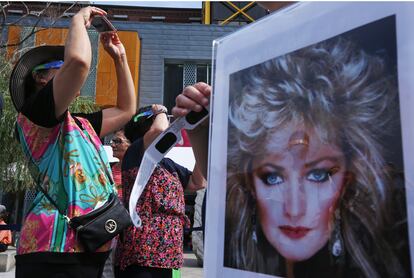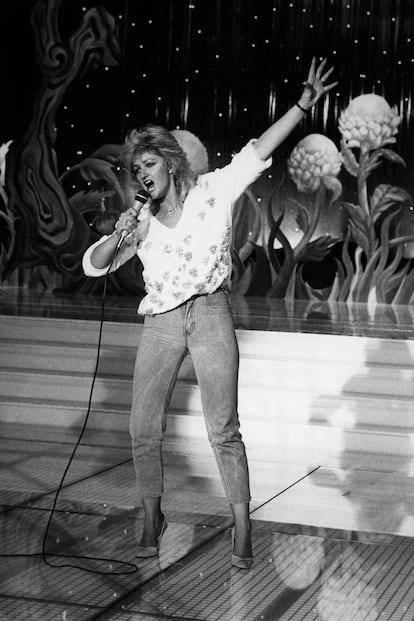How one of the most enigmatic music videos of the 1980s was made: ‘You are nothing more than a damn pervert’
Bonnie Tyler’s hit ‘Total Eclipse of the Heart’ has just reached one billion views on YouTube, 40 years after its release, which is no mean feat for a music video that doesn’t exactly have a plot

“What the hell is going on in this video?” a user on the NegGAF video game forum asked, referring to the 1983 hit Total Eclipse of the Heart. It earned Bonnie Tyler her first Grammy nomination and has sold more than eight million copies. Much of that success is due to the video, an audiovisual absurdity that combines ninjas, fencers, angels, the children of The Village of the Damned and, as the 1980s canons required, white doves, and curtains billowed by a hurricane-force wind that never manages to ruffle Tyler’s spray-hardened coiffure.
This audiovisual time capsule contains all the key elements of the most overblown and fanciful decade of music and it has just hit one billion views on YouTube. Let’s contextualize its success: very few music videos from that decade reach that particular milestone, which is nearly always reserved for current artists and runaway hits that sweep through the youth audience like a tornado. Some of them are transgenerational anthems like Take on me by A-ha, meme fodder like Never Gonna Give You Up by Rick Astley, rock classics like Sweet Child O’Mine by Guns N’ Roses, or The Final Countdown by Europe. In the case of Total Eclipse of the Heart, there’s something else: no one has yet managed to work out what it’s about. If you still don’t understand the video after watching it dozens of times, don’t worry: Bonnie Tyler doesn’t know either. “39 years later I still can’t explain this,” she wrote on her social media along with a photo of one of the bright-eyed students featured in the video — it’s in the lyrics.
Although the final product seems the result of a brainstorm in which no one wanted to give in, there is a certain order in this chaos that is supported by two of the biggest names in the 1980s music industry: Russell Mulcahy, the man who laid the foundations of music video aesthetics when they were just starting out, and Jim Steinman, “the Wagner of rock” in the words of Andrew LLoyd Webber, and author of bombastic ballads such as Meat Loaf’s I’d Do Anything for Love (But I Won’t Do That) and It’s All Coming Back to Me Now by Celine Dion.
Steinman confessed that the song is a vampire love story. “Its original title was Vampires In Love because I was working on a musical about Nosferatu. If anyone listens to the lyrics, they’re really like vampire lines. It’s all about the darkness, the power of darkness and love’s place in the dark...” In 1997, he had the opportunity to recycle it in its true meaning in the musical adaptation of The Vampire Ball, although it seems that Roman Polanski was not very amused.
Although it has been suggested that the song was originally meant for Meat Loaf and it was only through disagreements with the record company over financial issues that it ended up being sung by Tyler’s raspy vocals, it seems that the star of The Rocky Horror Picture Show and Fight Club was never even part of the equation. The Welsh woman had fallen in love with Steinman’s bombastic compositions while watching a performance by Meat Loaf himself and, faced with the urgent need for a success that had not come since It’s a heartache, she flew to New York to convince Steinman to write something for her. Steinman sat at the piano and Canadian singer Rory Dodd (the male voice who accompanies her with the unmistakable “Turn aroooound”) performed an early version of Total Eclipse of Heart.
Tyler enthusiastically accepted. “I thought she had one of the most passionate voices I’d heard in rock and roll since Janis Joplin,” the composer declared. Tyler put her own stamp on a song that was as majestic as it was difficult to execute. “Tyler’s voice is perfect for this thing.” “She sounds wrecked and destroyed, but she still summons the strength to leap from one huge note to the next,” observed Tom Breihan in a review published by Stereogum. “She doesn’t just sing the lyrics. She exorcises them from her body and casts them out into the world.”

The next thing was the music video, an indispensable element in the eighties, but still a new art that was beginning to forge its personality. “At first they served to show the group or singer, so that they could go where a tour could not, as happened when the Beatles stopped performing live shows and released music videos like Paperback writer,” explains Eduardo Viñuela, professor of musicology at the University of Oviedo and author of El videoclip en España (1980-1995): Gesto audiovisual, discurso y mercado [The video clip in Spain (1980-1995): Audiovisual gesture, discourse, and market]. “In the last decade its importance has increased, it is no longer just a promotional element in the industry, but a musical medium in the same vein as a vinyl record or a CD. YouTube has been the principal means of music consumption for more than a decade.”
To transform their awesome power ballad into images, they contacted the doyen of music video making, Russell Mulcahy. On his glittering resumé he could list such achievements as having been the director of the first music video ever broadcast on MTV, Video Killed the Radio Star by The Buggles. He was also the audiovisual mastermind for Duran Duran, with music videos such as Rio and the epic Wild Boys — he almost drowned Simon Le Bon after the watermill he was tied to stopped while the singer’s head was submerged in water. Mulcahy was also responsible for True by Spandau Ballet, Vienna by Ultravox, and Gipsy by Fleetwood Mac, which feature all the trademark elements of the ’80s video: windblown fabrics, perpetual fog, and a lot of male torsos. He repeated this aesthetic in his most successful and unclassifiable film: The Immortals, a woeful science fiction thriller with Christopher Lambert at the height of his attractiveness and Sean Connery fighting in a kilt to the tune of Queen. “It was the beginning of the MTV era and was something totally new. When they asked me for a video, there was no concept behind it, they simply sent me a tape with the song. I would listen to it with my eyes closed, I would come up with some ideas and write something down, and we would shoot the video the next day,” Mulcahy recalled.
MTV “was the definitive point of entry for music on television: everybody had one, and it was the most viewed means of communication. It is one of the first thematic television channels, a continuous flow of music aimed at young audiences. In a very short time it became the [dominant] youth channel, and influenced a generation that found new role models in music videos with which to distance themselves from their older siblings,” Viñuela points out. “It was especially important in broadcasting the new models of women in music. Thus, the music videos of Madonna, Cindi Lauper, and Tina Turner show empowered women, who appear in risqué looks and claim their space.”
Russell and Steinman joined forces. The composer suggested Bonnie Tyler’s white dress after watching Futureworld, the continuation of Yul Brynner’s futuristic thriller Metal Souls and the location chosen for the recording was Holloway Asylum, a sumptuous Victorian mental institution that was also the setting for another ‘80s anthem, Alphaville’s Forever Young. “I collaborated on the storyboard for Bonnie Tyler’s Total Eclipse of the Heart with Jim Steinman, who wrote and produced the song. Jim is fabulously, fabulously crazy. We would banter ideas over a bottle of red wine. I’d say, ‘Let’s set it in a school and have ninjas in one scene,’ and he’d say ‘Let’s have a choirboy with glowing eyeballs,’” the director revealed in the essential I Want My MTV: The Uncensored Story of the Music Video Revolution. The delirious result did not excite everyone equally. “We had one sequence, which was Steinman’s idea, where a shirtless young boy is holding a dove, and he throws the dove at the camera in slow motion. Bonnie came around the corner and screamed, in her Welsh accent, ‘You’re nothing but a fucking pervert!’ And she stormed off.”

The Welsh woman was not the only one who detected the obvious erotic subtext of the music video. “Wait, what is this video about? Is it about this woman’s repressed feelings of longing, lust, and fear toward her students?” Vulture asked. “It’s outrageously homoerotic,” wrote critic Steve Pafford, adding: “The possessed chorus boys in thong-like undies dancing around Tyler are astoundingly out there, even for the ‘80s. There would be screams of sexual exploitation of minors if they attempted it now.” Although Mulcahy denies it. “There was nothing perverse intended. The imagery was meant to be sort of pure. Maybe slightly erotic and gothic and creepy, but pure. Anyway, the video went to number one, and a year later Bonnie’s people rang up and asked if I would direct her new video. I told them to fuck off, because I was insulted about being called a fucking pervert.”
Seeing what’s on the other side
Bickering aside, Tyler’s performance is one of the keys to the success of the music video. “She seemed to instinctively understand that the best way to animate a Steinman song is to sing it like a crazy person — red-faced, flinging your arms every which way, single-handedly sucking every single molecule of oxygen out of the room,” Pafford wrote. The Welsh woman gave herself completely to the freewheeling style of a composer who once said: “If you don’t go too far, how are you going to see what’s on the other side?”
“Total Eclipse of the Heart is a classic, one of those music videos canonized by the passage of time for being the epitome of eighties aesthetics: Bonnie Tyler’s look, the gothic atmosphere, the spaces, the lighting, and the colors, everything responds to that kitsch exaggeration that has remained in the popular imagination of the decade. But, above all, because of the singer’s gestures and the grotesqueness of her dream narrative,” says Viñuela. Mulcahy’s video walks the fine line between the sublime and the ridiculous, the genius and the grotesque. Both the video and the lyrics allow for interpretation, but their cultural impact is unquestionable. Despite its vocal difficulty, it is one of the go-to karaoke and talent show songs, and we have heard it in dozens of series and movies. From Modern Family to Criminal Minds, from Futurama to Glee. At the beginning of the horror movie Urban Legend, Natalie Wood’s daughter is singing the song at the top of her lungs when a guy cuts off her head. Its validity is corroborated not only by the astronomical number of views on YouTube, but also by its parodies.
In 2021, a Welsh family went viral after creating the hilarious “literal” version, the work of content creator David A. Scott who adapts the lyrics explaining what happens in the music video: “Metaphor? / Close-up of some candles and dramatically posing / Then, stock footage of the moon in the sky,” as the lyrics go. It has received millions of views despite the record company’s continuous efforts to block it. And, of course, every time there is an eclipse, their sales multiply. Tyler herself performed the song on a cruise during the 2017 solar eclipse. “We can’t say that it holds up well over the years,” Viñuela concludes, “but it is inevitable that viewing it today evokes nostalgia and is tinged with mixture of shame and tenderness”.
Sign up for our weekly newsletter to get more English-language news coverage from EL PAÍS USA Edition
Tu suscripción se está usando en otro dispositivo
¿Quieres añadir otro usuario a tu suscripción?
Si continúas leyendo en este dispositivo, no se podrá leer en el otro.
FlechaTu suscripción se está usando en otro dispositivo y solo puedes acceder a EL PAÍS desde un dispositivo a la vez.
Si quieres compartir tu cuenta, cambia tu suscripción a la modalidad Premium, así podrás añadir otro usuario. Cada uno accederá con su propia cuenta de email, lo que os permitirá personalizar vuestra experiencia en EL PAÍS.
¿Tienes una suscripción de empresa? Accede aquí para contratar más cuentas.
En el caso de no saber quién está usando tu cuenta, te recomendamos cambiar tu contraseña aquí.
Si decides continuar compartiendo tu cuenta, este mensaje se mostrará en tu dispositivo y en el de la otra persona que está usando tu cuenta de forma indefinida, afectando a tu experiencia de lectura. Puedes consultar aquí los términos y condiciones de la suscripción digital.
More information
Archived In
Últimas noticias
Most viewed
- David King, chemist: ‘There are scientists studying how to cool the planet; nobody should stop these experiments from happening’
- Reinhard Genzel, Nobel laureate in physics: ‘One-minute videos will never give you the truth’
- Mexico completes its trade shift with the entry into force of tariffs on China and countries without trade agreements
- Oona Chaplin: ‘I told James Cameron that I was living in a treehouse and starting a permaculture project with a friend’
- Sinaloa Cartel war is taking its toll on Los Chapitos










































